Industrial Exhaust Fans Vs. Industrial Ceiling Fans
Facility managers and engineers are always looking for the most efficient and cost-effective ways to maintain their industrial facilities. One of the primary considerations is how to ensure adequate ventilation and air circulation in large commercial spaces. Industrial exhaust fans and industrial ceiling fans (HVLS - High Volume Low Speed fans) are two common types of fans used in these spaces. This blog will highlight the differences between the two, as well as their benefits and drawbacks.
Table of Contents
What is an Industrial Exhaust Fan?
Ventilation and Air Circulation
What is an Industrial Ceiling Fan?
What is an industrial exhaust fan?

Industrial exhaust fans are designed to move large volumes of air in harsh environments. These fans are typically mounted on a wall or a roof, and they are used to control the temperature and humidity levels of the space they are installed in. They are commonly used in industries such as manufacturing and agriculture where air quality is critical.
Industrial exhaust fans are designed to remove airborne contaminants, such as fumes, smoke, and other particulates from the environment. They are powerful ventilation fans, typically installed in duct systems that pull air through a commercial space and push it outside.
Industrial Exhaust Fans are Heavy Duty
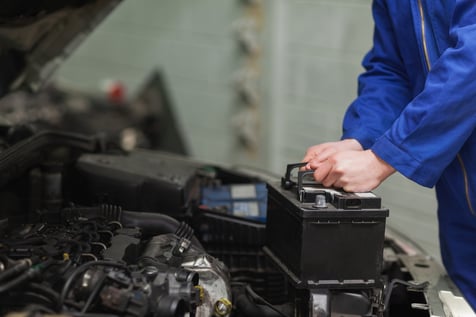
Industrial exhaust fans are built to withstand harsh environments, including exposure to moisture, dust, and chemicals. They are typically constructed of steel or aluminum and have corrosion-resistant coatings that help protect them from the elements. They also feature motors designed to run for extended periods without overheating or breaking down.
Industrial Exhaust Fans are Designed to Remove Airborne Contaminants
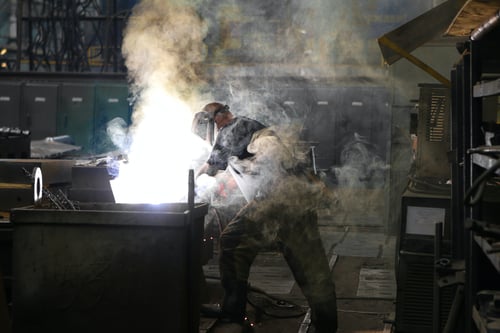
One of the primary functions of industrial exhaust fans is to remove airborne contaminants from the workplace. These contaminants can include dust, fumes, smoke, and other particulate matter that can be hazardous to the health of employees. By removing these contaminants from the air, industrial exhaust fans help ensure a safe and healthy working environment.
Industrial Exhaust Fans are Great for Ventilation and Air Circulation
In addition to removing airborne contaminants, industrial exhaust fans also provide ventilation and air circulation in commercial spaces. They help regulate temperature and humidity levels, which can also help to improve employee comfort and productivity.
Best Uses for Industrial Exhaust Fans
Industrial exhaust fans are ideal for spaces where airborne contaminants are a concern. They are commonly used in industries such as manufacturing and agriculture where employees are exposed to fumes, dust, and other particulate matter or where they have to draw air out of the facility. They are also commonly used in commercial kitchens and other spaces where ventilation is critical.
Cost of Ownership and Pricing

Industrial exhaust fans can be expensive to purchase and install, but they are generally low-maintenance and have a long lifespan. The cost of ownership can vary depending on factors such as the size of the space, the type of fan, and the frequency of use.
What is an industrial ceiling fan?
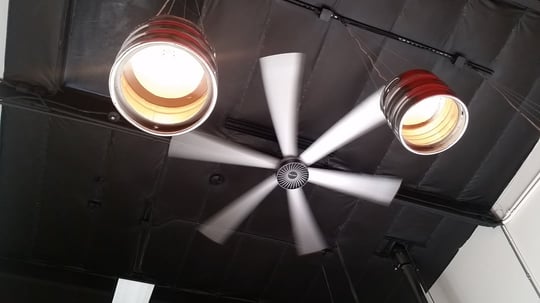
Industrial ceiling fans are very large fans called HVLS (high volume low speed) fans. These fans are designed to move large volumes of air at low speeds. They are typically installed on the ceiling of a commercial or industrial space and are used to improve air circulation, regulate temperature and humidity, and improve employee comfort. Industrial ceiling fans typically range in size from 6-24 feet in diameter. These fans are typically used in large facilities such as warehouses, distribution centers, and manufacturing plants. However, they are not limited to these spaces. They also work great in commercial spaces like restaurants, stores, malls, airports, and garages. They also can easily be installed in a home with vaulted ceilings or a covered patio. Industrial ceiling fans can cover a much larger area than traditional fans.
Industrial Ceiling Fans are Also Heavy Duty
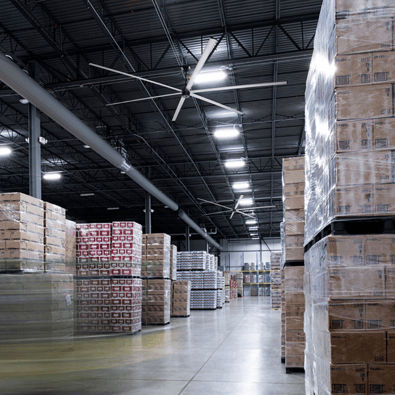
Industrial ceiling fans are designed for use in harsh environments. They are typically constructed from heavy-duty materials such as steel or aluminum and feature enclosed motors that are designed to withstand the wear and tear of continuous use in an industrial setting like a warehouse or distribution center. The enclosed motor also protects it from the elements. Fans are generally rated safe to use inside or outside. Safety features such as automatic shutdown in the event of overheating or overloading are also common.
Industrial ceiling fans are commonly available in both direct drive and gear drive. Direct drive motors are very quiet fans. That is because there is less friction within the motor because there are no gears, which leads to an overall quieter performance. They are also very low maintenance because there are fewer moving parts. Gear drive motors use a series of gears to create major torque. They are generally more heavy-duty and build to withstand even the harshest of environments.
Industrial Ceiling Fans have Multiple Speeds and Directions
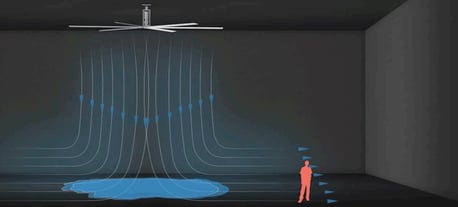
One of the key features of industrial ceiling fans is that they typically have multiple speeds and can be reversed, allowing them to be used for both summer and winter operations. During the summer, the fans can be set to push air downward, creating a cooling effect on people and equipment below. During the winter, the fans can be set to push air upward, moving the warm air trapped near the ceiling down to the floor. This flexibility allows facility managers and engineers to fine-tune the airflow to meet the needs of their specific space.
Industrial Ceiling Fans Have a Big Area of Coverage
Industrial ceiling fans are designed to cover large areas with a single fan. In fact, one fan can cover up to 20,000 square feet. This is achieved through the use of large blades that are typically 6 to 24 feet in diameter. MacroAir fans have a NASA-inspired airfoil blade shape that helps to effectively move the air precisely throughout the space. The slow speed of the blades allows them to move large volumes of air without creating excessive noise or causing air turbulence.
Best Uses for Industrial Ceiling Fans
Industrial ceiling fans are ideal for large industrial and commercial spaces that require constant air circulation. They are particularly well-suited for facilities with high ceilings, as they can help to equalize temperature differences between the floor and ceiling. This helps to create a more comfortable environment for workers within the facilities. In fact, MacroAir HVLS fans create a cooling effect that can help people feel up to 15° F cooler. Industrial ceiling fans can also help to reduce the amount of dust and other airborne particles in the air by increasing the overall ventilation within the facility. In turn, improving air quality and reducing the risk of respiratory problems.
Cost of Ownership and Pricing

Industrial ceiling fans are typically more expensive than industrial exhaust fans. However, they are designed to be extremely energy efficient and can help to reduce heating and cooling costs by improving air circulation. In fact, adding a MacroAir industrial ceiling fan can save you up 30% in your energy costs. That means the overall cost of ownership throughout the life of the fan is typically lower than that of an industrial exhaust fan due to the reduced energy usage.
How do Industrial Exhaust Fans and Industrial Ceiling Fans Compare?
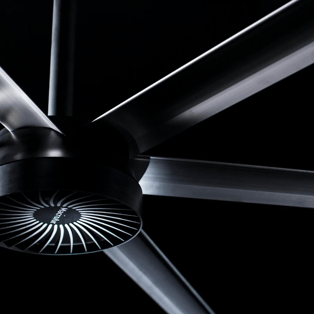
Industrial exhaust fans and industrial ceiling fans are designed for different purposes, but they do have some similarities. Both types of fans are designed for use in harsh environments, and both are typically constructed from heavy-duty materials. However, there are also some key differences between the two types of fans.
Airflow
The primary function of an industrial exhaust fan is to remove air from a space, while the primary function of an industrial ceiling fan is to circulate air throughout a space. Exhaust fans are typically designed to create a negative pressure within a space, drawing air out of the space and exhausting it outside. HVLS ceiling fans, on the other hand, are designed to move large volumes of air slowly, creating a gentle breeze that circulates air throughout a space.
Pressure
Industrial exhaust fans typically operate at a high pressure, creating a negative pressure within a space that draws air out of the space. Industrial ceiling fans, on the other hand, operate at a low pressure, moving large volumes of air slowly throughout a space.
Design
Industrial exhaust fans are often designed to remove airborne contaminants from a space, including fumes, smoke, and other airborne particles. They are heavy-duty products that are designed to withstand harsh environments and can efficiently circulate air in a facility. Additionally, they are cost-effective, making them an ideal option for businesses on a budget.
Industrial ceiling fans also effectively remove airborne contaminants from the air. In a recent study, the Air Movement and Control Association International (AMCA International) determined that adding industrial ceiling fans to a large space can actually help to reduce the distribution of airborne particles, which can actually help to reduce the spread of airborne particles like COVID-19. Industrial HVLS ceiling fans are also excellent at improving airflow and maintaining a consistent temperature in large spaces. They are also heavy-duty products that are designed to withstand harsh environments, and their enclosed motors make them safe to use in commercial and industrial settings. The multiple speed and direction settings make them a versatile option for businesses looking to improve air movement and circulation in their facilities.
Next Steps
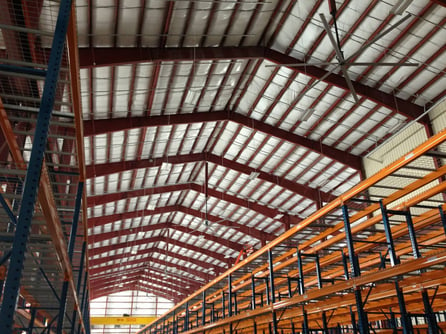
When choosing between an industrial exhaust fan and an industrial ceiling fan, it is important to consider the specific needs of your business or facility. Both types of fans have their place. Understanding the differences between the two types of fans can help facility managers and engineers make informed decisions when choosing the right model to improve their facilities' air quality, ventilation, and temperature. Ultimately, the decision between an industrial exhaust fan and an industrial ceiling fan depends on the specific needs of your business and budget. Take the time to dive into what that looks like for your facility.
Regardless of your choice of industrial fan, investing in the right one will effectively help improve employee productivity and morale, reduce operating costs, and ensure a safe and healthy work environment.
For more information on industrial ceiling fans, check out the benefits of MacroAir fans by clicking the link below.
About MacroAir
MacroAir invented the High Volume, Low Speed (HVLS) industrial ceiling fan. They have continued to be a leader in the market by developing the most innovative large fans in the world. They continually strive to push boundaries and set the bar when it comes to engineering and product development. MacroAir technology is based on the principle that moving air slowly is far more efficient than moving air quickly. Their HVLS fans move air down and out in all directions, keeping the air fresh and helping people and animals feel more comfortable. Comparatively, MacroAir products are unparalleled in energy efficiency and airflow. They are assembled in the USA and installed worldwide. Customers benefit from local service and highly customized solutions from MacroAir’s global distribution network.

